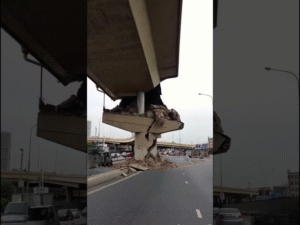
In the wake of a recent earthquake, residents in the affected area witnessed a startling sight — a section of a bridge support had suffered severe damage, causing part of it to collapse. The failure was limited to the bridge’s outer concrete layer, with the underlying structural components remaining intact. While the event was concerning, the fact that the main load-bearing elements were spared prevented a far more serious outcome.
Eyewitnesses reported hearing a loud cracking sound as the earthquake’s tremors rippled through the area. Dust rose from the base of the bridge, and chunks of concrete fell away, revealing the inner framework. Within minutes, local authorities and emergency crews arrived to assess the scene, block off the affected section, and redirect traffic to ensure public safety.
Engineers on-site confirmed that the damage, while significant in appearance, was mostly superficial. Still, they stressed that even outer-layer failures can pose hazards and require immediate attention. Temporary reinforcements were put in place to stabilize the area until full repairs could be carried out.
The quick and coordinated response by emergency services helped prevent any injuries. Local transportation officials praised the public for following detour signs and avoiding the site, which allowed crews to work efficiently without interference.
This incident highlights the importance of routine inspections and maintenance, especially in regions prone to seismic activity. Infrastructure experts point out that earthquakes, even of moderate magnitude, can weaken structures over time, making early detection of vulnerabilities critical.
Authorities have since announced plans for a comprehensive review of all bridges in the surrounding area to ensure they meet updated safety standards. While this particular incident ended without harm, it serves as a reminder that preparedness, rapid action, and community cooperation play a vital role in minimizing risks during natural disasters.





